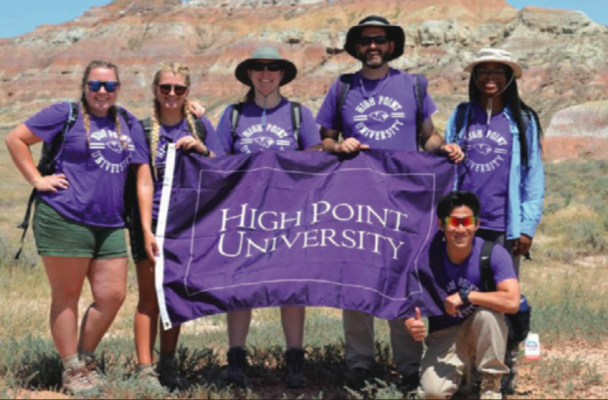Digging up the past with some HPU undergrads

By Nicholas Bainbridge // News Editor
During summer break, several groups of students participated in the High Point University Summer Research Program and worked at several locations performing studies and gathering data on multiple topics such as biology and chemistry.
The program often referred to as SuRPS is a summer session where students can perform research under the guidance of a professor, uses their expertise to facilitate the student’s development relevant skills and the project as a whole.
Two of the research groups, led by biology professors Dr. George Christian and Dr. Heather Ahrens, traveled to the Big Horn Basin in Wyoming to investigate the fossils in the area. Much of their efforts focused on the mammal fossils in the Willwood Formation Christian’s group, including undergraduate students Alan Hsueh and Kenedy Jackson, focused on uncovering samples from the Early Eocene Era, a period which began over 50 million years ago and was characterized by its high temperature and multiple species being replaced with ones more suitable to thrive in the new environment caused by the shift in climate.
This team was responsible for finding samples from the era of interest and had to make use of geographic information systems and positioning systems to determine how far they needed to dig to find the rock layer they required.
According to the researcher’s abstract from the SuRPS Final Research Symposium, where all research teams presented their projects, finding the right range is not as simple as just measuring the depth of the hole.
“The challenge of associating each locality to a specific interval is that not every layer is at the same depth across the basin,” the researchers explained.
The endeavor was not only a mental challenge for the students but a physical one as well. Combing the basin for samples proved to be exhausting work, mainly due to the harsh environmental factors such as the scorching heat.
“It was so hot and if you thought about wearing short sleeves you were dead wrong because the sun was at full blast, making it 120 degrees every day so you had to wear long sleeved clothing to prevent sunburn and dehydration.”
Even Mr. Hsueh explained that the experience proved quite fruitful and was glad for the opportunity to work on the project.
Ahrens, along with her students Hannah Cozart and Ricki Luongo, focused on analyzing the dental development of the Esthonyx, an extinct, ground-dwelling herbivore characterized by its elongated mouth and teeth. The purpose of the research was to use the Esthonyx as a case study to further the understanding of the reasons for the evolution of mammals in response to shifts in climate.
Their examination of 20 samples of the creature allowed them to discover a slight trend in the structure of the animal’s teeth over time; however, they claimed more research needs to be done before they can form a more confident conclusion.
“All plots showed increasing centroid size over time, with the exception of p4; however, the linear relationship was weak. Additional larger sample sizes will aid in drawing conclusions about lineage evolution, as well as species identification,” the abstract stated.
There were several other research groups studying projects from the beginning of June to the end of July, and there will be more next year for researchers old and new.